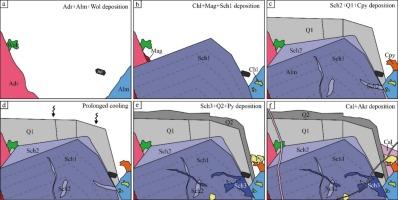Scheelite deposition induced by long cooling time in the Longjiaoshan skarn tungsten deposit in South China: Evidence for petrography and fluid inclusions
IF 3.6
2区 地球科学
Q1 GEOLOGY
引用次数: 0
Abstract
Tungsten (W), one of the most important critical strategic metals, is mainly formed in skarn deposits from magmatic hydrothermal systems. The precipitation mechanism of W in hydrothermal environments remain debated, primarily due to scarcity of direct in-situ fluid evidence from scheelites that could constrain W mineralization process. This study systematically reconstructs the fluid evolution history of the Longjiaoshan deposit, a representative large skarn W deposit in South China, based on integrated field investigations, petrographic observations, infrared microthermometry, cathodoluminescence (CL) imaging, Raman microspectroscopy and LA-ICP-MS analysis of intergrown scheelite and gangue mineral assemblages. The scheelite mineralization ore at Longjiaoshan deposit developed through two principal stages (i.e., retrograde skarn formation and subsequent sulfide stages). Scheelite (Sch1: euhedral, crystals with homogeneous gray CL, response and well-defined oscillatory zoning) precipitated during a discrete interval between garnet crystallization and subsequent quartz (Q1) formation. Then Sch2 (anhedral morphology with gray CL signature, displaying microcracks and fissures) co-precipitated with Q1 quartz). Sch3 (exhibiting dark CL luminosity and irregular oscillatory zoning) was overprinted by later Q2 quartz veins. Then the sulfide mineralization (chalcopyrite and pyrite) cross-cut pre-existing mineral phases. Microthermometric analysis of 71 fluid inclusion assemblages (FIAs), comprising 90 individual inclusions in scheelite and quartz from the Longjiaoshan deposit, yielded the following homogenization temperatures and salinities (468 to 575.1 ℃ and 10.6 to 17.4 wt% NaCl eq. for Sch1, 371.0–482.1 ℃ and 10.6 to 17.7 wt% NaCl eq. for Sch2, 397.4–458.1 and 10.6–13.7 wt% NaCl eq. for Sch3, 265.0–395.1 ℃ and 5.3–12.5 wt% NaCl eq. for Q1, and 209.3–300.8 ℃ and 8.3–12.4 wt% NaCl eq. for Q2, respectively). The Rb/Na versus K/Na ratio plot of fluid inclusion compositions demonstrates magmatic fluid signatures, consistent with exsolution from a homogeneous magma reservoir. The progressive temperature decline through successive mineralization stages therefore corresponds to downward gradual migration of the magma interface. The B and As diagram from fluid inclusion data reveal limited fluid phase segregation and vapor phase during boiling. In-situ microanalysis of primary / pseudosecondary fluid inclusions from the different crystallization stages indicates that inconspicuous fluid phase segregation and vapor phase during boiling. Integration of SEM-CL imaging, infrared microthermometry, Raman microspectroscopy, and fluid inclusion LA-ICP-MS analyses demonstrates that scheelite precipitation at the Longjiaoshan deposit was controlled by prolonged cooling.

华南龙角山夕卡岩型钨矿床长冷却时间诱导的白钨矿沉积:岩石学和流体包裹体证据
钨是一种重要的战略金属,主要形成于岩浆热液体系中的夕卡岩矿床。热液环境中W的沉淀机制仍然存在争议,主要是由于缺乏来自白钨矿的直接原位流体证据,这些证据可能限制W的成矿过程。本文通过综合野外调查、岩相观察、红外显微测温、阴极发光(CL)成像、拉曼显微光谱和白钨矿与脉石共生矿物组合的LA-ICP-MS分析,系统重建了华南代表性的大型矽卡岩型钨矿龙角山矿床的流体演化史。龙角山白钨矿化矿发育经历了两个主要阶段(即逆行矽卡岩形成阶段和其后的硫化物阶段)。白钨矿(Sch1:自面体,具有均匀的灰色CL,响应和明确的振荡带)在石榴石结晶和随后的石英(Q1)形成之间的离散间隔中沉淀。然后与Q1石英共析出Sch2(具有灰色CL特征的六面体形态,显示微裂纹和裂隙)。Sch3(暗CL亮度和不规则振荡带)被后期Q2石英脉覆盖。然后硫化物矿化(黄铜矿和黄铁矿)横切原有矿物相。对龙角山矿床白钨矿和石英中包含90个包裹体的71个流体包裹体组合(FIAs)进行显微测温分析,得到均匀温度和盐度分别为:Sch1为468 ~ 575.1℃和10.6 ~ 17.4 wt% NaCl当量,Sch2为371.0 ~ 482.1℃和10.6 ~ 17.7 wt% NaCl当量,Sch3为397.4 ~ 458.1和10.6 ~ 13.7 wt% NaCl当量,Q1为265.0 ~ 395.1℃和5.3 ~ 12.5 wt% NaCl当量,Q2为209.3 ~ 300.8℃和8.3 ~ 12.4 wt% NaCl当量。流体包裹体Rb/Na与K/Na比值图显示岩浆流体特征,与均质岩浆储层的出溶相一致。因此,在连续的成矿阶段中,温度逐渐下降对应于岩浆界面的逐渐向下迁移。流体包裹体数据的B和As图揭示了沸腾过程中有限的液相偏析和气相。对不同结晶阶段的原生/伪次生流体包裹体的原位显微分析表明,沸腾过程中存在不明显的液相偏析和气相。综合SEM-CL成像、红外显微测温、拉曼显微光谱和流体包裹体LA-ICP-MS分析表明,龙角山矿床白钨矿沉淀受长时间冷却控制。
本文章由计算机程序翻译,如有差异,请以英文原文为准。
求助全文
约1分钟内获得全文
求助全文
来源期刊

Ore Geology Reviews
地学-地质学
CiteScore
6.50
自引率
27.30%
发文量
546
审稿时长
22.9 weeks
期刊介绍:
Ore Geology Reviews aims to familiarize all earth scientists with recent advances in a number of interconnected disciplines related to the study of, and search for, ore deposits. The reviews range from brief to longer contributions, but the journal preferentially publishes manuscripts that fill the niche between the commonly shorter journal articles and the comprehensive book coverages, and thus has a special appeal to many authors and readers.
 求助内容:
求助内容: 应助结果提醒方式:
应助结果提醒方式:


